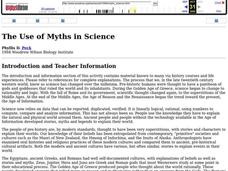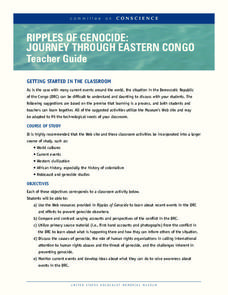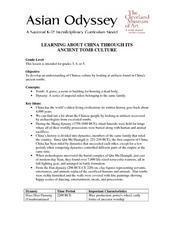Curated OER
The Use of Myths in Science
Students examine folk tales to determine the basis for scientific myths. They demonstrate through the discussion of the folk tales that the perception of the world has changed as new information is gained. They write their own folk...
Curated OER
It's Alive! Using Microorganisms in Cooking
Learners create a KWL chart about food. In this chemistry instructional activity, students differentiate physical and chemical changes. They explain how microorganisms are used in food preparation.
NY Learns
Geography of the Fertile Crescent by ECSDM
Using Google Earth, a vocabulary assignment, and map handout, your class members will outline the Fertile Crescent in Mesopotamia and identify the source of the Tigris and Euphrates rivers. They will then complete graphic organizers...
US Holocaust Museum
Ripples of Genocide: Journey through Eastern Congo
Could you locate the Democratic Republic of Congo on a map? Scholars investigate the genocide taking place in Eastern Congo. Groups explore web-based evidence as well as the Ripples in Genocide source to take a closer look at the issue....
Student Handouts
What Year Is It?
This page includes a space to write in the date, but what does the date even mean? And where does it come from? Inform your class about the various calendars and how the Western calendar came into widespread use with an informational...
School District of Palm Beach County
Timelines
What do BC and AD mean on a timeline? What is the difference between a decade and a century? Here is a nice handout that offers all the foundational knowledge your young historians will need on how to look at historical timelines.
Curated OER
Mysteries of Egypt
Students investigate the Egyptian civilization. In this cultural lesson, students watch the film Mysteries of Egypt and create a replica of an ancient Egyptian artifact.
Curated OER
What is Islam? Who Are Muslims?
Ninth graders discover Muslim beliefs. In this Islam instructional activity, 9th graders identify biases and stereotypes about Muslims. Students then research the cultures and traditions of Muslim nations creating PowerPoint...
Curated OER
Chinese Philosophies
Pupils compare Confucianism and Daoism. For this Chinese culture lesson, students listen to a lecture comparing the religious philosophies and take a quiz at the end of the lesson.
Curated OER
China's Ancient Tomb Culture
Students research and discuss Chinese history through the examination of ancient tomb artifacts. Emphasis is placed on the creation of student posters displaying "what they would put in a tomb".
Curated OER
Roman Art, Architecture, and Engineering
There is no better tool to help you explain art or architecture than an image-filled slide show. Classic Greek art, architecture, and engineering are all described with excellent visual examples and text which defines each form by its...
Curated OER
In Old Pompeii
Students investigate the history of Pompeii and its destruction. They take a virtual field trip to the ruins of Pompeii, create a travel brochure to attract tourists to the site, and write an account of their trip.
Edgate
Learning From the Past: Origin of the Modern Summer Games
Where did our beloved Summer Games originate? Kids look for the origins of the Summer Olympics in our ancient past. They research how the Games came to be and how they have changed. They'll complete Venn diagrams to compare and contrast...
Curated OER
Inca Artifacts and Civilization Lesson Plans
By learning about Inca artifacts and this ancient civilization students can delve into history, geography, and much more.
Curated OER
World History: Why Civilizations Fall
Students examine factors leading to the demise of ancient civilizations. They list causes that led to the downfall of these societies. Students conduct Internet research and participate in online archaeological investigations.
Curated OER
Rich Chocolate: Mayan and Aztec use of Chocolate
Students conduct Internet research to discover how Mesoamerican's used chocolate. In this South American history lesson, students work in pairs to complete an activity worksheet and engage in class discussion.
Curated OER
The Sunni/Shia Split in Iraq
Students examine the historic Shia-Sunni conflict to assess its present-day status in Iraq and determine how it might play out in postwar Iraq. In this World History lesson plan, students research the factors that contribute to the...
Curated OER
Maya Lesson Plans
Mayan cities may have mysteriously disappeared, but the culture still thrives today. Maya lesson plans bring the culture alive.
Curated OER
Self-Portrait Unit - Lesson #1
Fourth graders create self-portraits using artistic elements found in Hispanic culture and, specifically, the art of Frida Kahlo. The lesson can be adapted for any culture/country and requires an outside person with cultural knowledge.
Curated OER
A World of Myths
Students read and write myths. In this world mythology lesson, students read and analyze myths from various cultures and then recognize their attributes as they write their own myths to explain natural phenomena.
Curated OER
Latin American Art
Latin American art lessons can provide a way to explore different cultures, the lives of famous artists, and much more.
Curated OER
Pharaoh Phonetics
Students explore ancient Egypt. In this Egypt lesson, students use the Internet to research ancient Egypt and then participate in several activities that help them better understand Egyptian culture.
Curated OER
CyberHunt: Ancient China
Learners participate in various web based activities about ancient China in order to discover the accomplishments of this extraordinary culture. For this history lesson, students explore the Chinese paper making recipes, and the special...
Curated OER
Ceramics Scientific Inquiry Through Chinese Art
Fourth graders explore, examine and study ceramics, a medium of historical importance to China. They review the advanced technology of the early Chinese civilization and are introduced to the scientific method of inquiry and make...

























